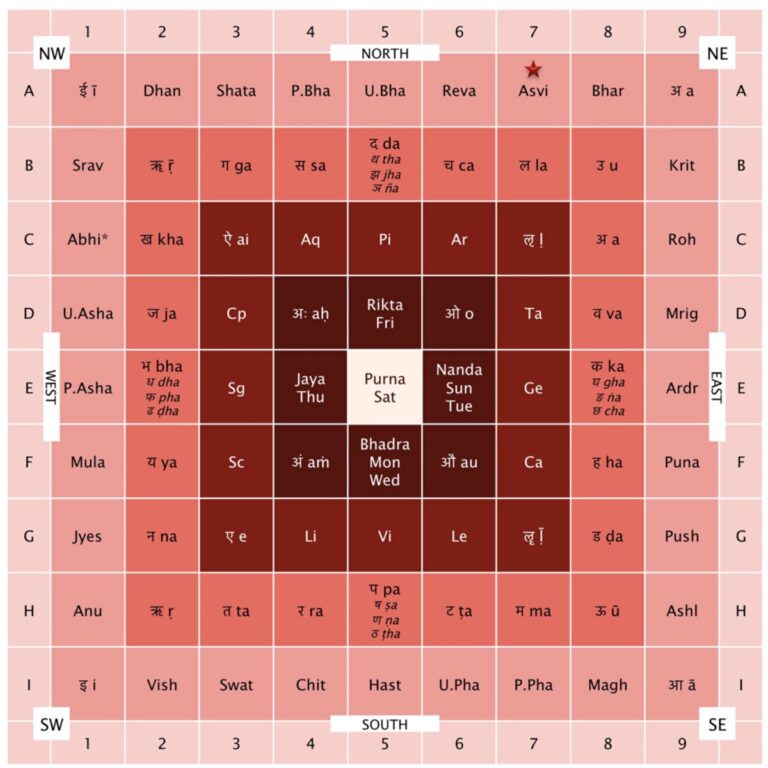Sarvatobhadra Chakra
1.INTRODUCTION:
Sarvatobhadra Chakra is a tool used as part of Transit of Planets. The term Savatobhadra means overall auspiciousness (sarva- overall; bhadra- auspiciousness) and takes into consideration almost all factors in vedic atrology viz., the 28 nakshatras, the 12 signs, the 30 tithis, the 7 weekdays and the 50 aksharas (Sankrit Alphabets) and hence can be used for variety of analysis of planetary transits. Although the prime focus here is analysis of transits, this can also be used for natal horoscope, dasa analysis etc.
This chart contains 9*9 = 81 boxes containing the nakshatras, signs, tithis, weekdays or the aksharas. For reference purpose I have given the names to the column from 1 to 9 and that to the rows as A to I, although this is not done in the astrological texts and other astrologers. I find giving names to the rows and columns will make it easier to refer to a particular boxes. In subsequent article, the boxes will be referred as A1 (row A, column 1), I9 (row I, column 9) etc.

2. THE CONCEPT OF VEDHA
The concept of vedha is very important in transit analysis. We can encounter this concept while studying transits of planets from natal Moon and hence its understanding is vital in any studies of transits. Vedha means to pierce and hence can means the power of a planet to influence a favourable or unfavourable result. While in normal transits of planets, vedha of other planets can nulify the benefic or malefic influences, in Sarvatobhadra Chakra, the Vedha shows the influence of transiting (or natal) planets on various nakshtras, signs, tithis, aksharas etc. The vedha of benefics are considered to be favouable and that of malefics are considered as unfavourable. The influence is stronger if they are exalted and retrograde while weaker if they are debilitated.
2.1. TYPES OF VEDHA
There are three types of vedha:
1. Across vedha: When seen from a transiting planet, the bodies falling across in the Sarvatobhadra chakra comes under vedha from the said planet. Thus when the planets transit on the nakshatra in the left wall of the chakra, the across vedha will be on the nakshatras (and bodies) towards the right and vice versa. Similarly when the planets transit the nakshatras on the upper wall of the chart, the accross vedha will be downward. This vedha is more effective if the planets are in normal motion or stationary.
2. Fore vedha: When seen from a transiting planet, the bodies falling in the diagonal seen in clockwise (zodiacal) direction are under fore vedha. This vedha becomes effective when the planets are moving fast. This vedha is always more important for the Lumineries, whose motion is always in forward direction.
3. Hind (rear) vedha: When seen from the transiting planet, the bodies falling in the diagonal seen in anticlockwise (antizodiacal) direction are under hind vedha. This vedha becomes effective when the planets are in retrograde motion, as their sight is backward. This vedha is always effective for the nodes since they always move in retrograde motion.
We have seen that that the impact of the vedha in one of the direction is dependent on the motion of the 5 planets, excluding the luminaries and the nodes. When the planets are stationary or moving in normal pace, the across vedha is more effective than others and when moving in faster motion or retrogression, fore or hind vedha becomes effective respectively. Since the Luminaries always move in forward direction, the fore vedha is always effective, while rear vedha is always ineffective. Similarly, since the nodes are always in retrograde motions, the hind vedha is always effective and fore vedha is always ineffective.
Astrology Guruji
Your Friend & Guide
Get in touch
- t-11, Nri City, Greater Noida,Uttar Pradesh, India
- +91-7906288015 , +91-7900335697
- +91-8449314347
- Mon-Fri 11:00 AM – 20:00 PM Sat-Sun 16:00 pM – 20:00 PM
- astrologyguruji1@gmail.com


